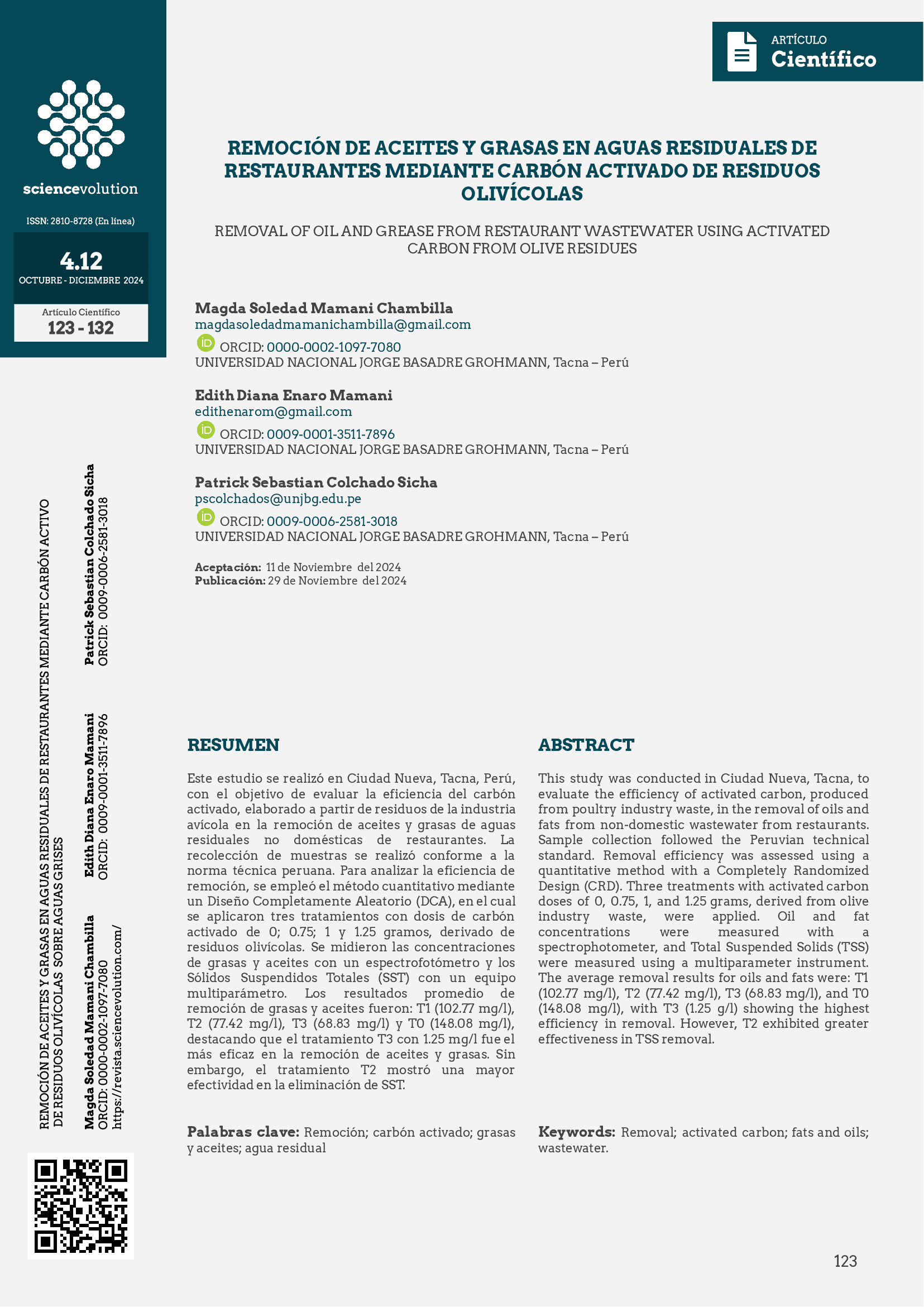Abstract
This study was conducted in Ciudad Nueva, Tacna, to evaluate the efficiency of activated carbon, produced from poultry industry waste, in the removal of oils and fats from non-domestic wastewater from restaurants. Sample collection followed the Peruvian technical standard. Removal efficiency was assessed using a quantitative method with a Completely Randomized Design (CRD). Three treatments with activated carbon doses of 0, 0.75, 1, and 1.25 grams, derived from olive industry waste, were applied. Oil and fat concentrations were measured with a spectrophotometer, and Total Suspended Solids (TSS) were measured using a multiparameter instrument. The average removal results for oils and fats were: T1 (102.77 mg/l), T2 (77.42 mg/l), T3 (68.83 mg/l), and T0 (148.08 mg/l), with T3 (1.25 g/l) showing the highest efficiency in removal. However, T2 exhibited greater effectiveness in TSS removal.
References
Azabache, Y., Murrieta, E., García, P., Ayala, M., Caceres, G., & Garcia, M. (2020). Treatment of residual water from a slaughterhouse: Efficiency of the coagulation - flocculation process. Agroindustrial Science, 10(1), 23-27. https://doi.org/10.17268/agroind.sci.2020.01.03
Banan Khorshid, Z., Mahdi Doroodmand, M., & Abdollahi, S. (2021). UV–Vis. spectrophotometric method for oil and grease determination in water, soil and different mediates based on emulsion. Microchemical Journal, 160, 105620. https://doi.org/10.1016/j.microc.2020.105620
Briones Ponce, G. E., Burgos Briones, G. A., Rosero Delgado, E. A., & Moreira Mendoza, C. A (2020). Aplicaciones de sales inorgánicas en el tratamiento de aguas residuales industriales procedente de la refinación de aceites y grasas. Colón Ciencias, Tecnología y Negocios, 7(2), 55-75. https://doi.org/10.48204/j.colonciencias.v7n2a4
Cabrera, M., Montenegro, L., & Jiménez, A. (2022). Análisis de un Sistema de Tratamiento de Aguas Residuales de una Industria de Embutidos. Revista Politécnica, 49(2), 47-54. https://doi.org/10.33333/rp.vol49n2.05
Casanova Núñez-Melgar, D. P. (2022). Guía Técnica del Cultivo de Olivo en la Región Tacna. Instituto Nacional de Innovación Agraria. https://hdl.handle.net/20.500.12955/1655
Decreto Supremo Nº 010-2019-VIVIENDA. (2019, 11 de marzo). Normas legales, N° 17. Diario Oficial El Peruano. https://cdn.www.gob.pe/uploads/document/file306588/DS_010-2019-VIVIENDA.pdf?v=155476035
Del Angel, E., Pantoja, M. A., López, R., & Cruz, A. E. (2022). Treatment of domestic wastewater using activated carbon prepared from sugarcane bagasse. Tecnología y ciencias del agua, 13(1), 144-183. https://doi.org/10.24850/j-tyca-2022-01-04
Fúquene, D. M., & Yate, A. V. (2018). Ensayo de jarras para el control del proceso de coagulación en el tratamiento de aguas residuales industriales. Documentos De Trabajo ECAPMA, 2(1). https://doi.org/10.22490/ECAPMA.2771
Hernández-Rodríguez, M., Otero-Calvis, A., Falcón-Hernández, J., & Yperman, Y. (2017). Características fisicoquímicas del carbón activado de conchas de coco modificado con HNO3. Revista Cubana de Química, 29(1), 26–38. ttps://www.redalyc.org/articulo.oa?id=443550986003
INACAL. (2016). AGUAS RESIDUALES. Protocolo de muestreo de aguas residuales no domésticas que se descargan en la red de alcantarillado. Dirección de Normalización - INACAL. Norma Técnica Peruana. NTP 214.060:201.
Jaén Jiménez, J. C., & Zamora Umaña, G. J. (2024). Obtención de carbón activado a partir del bagazo de caña, para su uso en la remoción de los fármacos diclofenaco y amoxicilina en aguas residuales. Revista Ciencia y Salud Integrando Conocimientos, 8(2), 53-66. https://doi.org/10.34192/cienciaysalud.v8i2.766
Lustosa Filho, J. F., Da Silva, A. P. F., Costa, S. T., Gomes, H. T., De Figueiredo, T., & Hernández, Z. (2024). Biochars Derived from Olive Mill Byproducts: Typology, Characterization, and Eco-Efficient Application in Agriculture—A Systematic Review. Sustainability, 16(12), 5004. https://doi.org/10.3390/su16125004
Medeiros, A. D. M. D., Silva Junior, C. J. G. D., Amorim, J. D. P. D., Durval, I. J. B., Costa, A. F. D. S., & Sarubbo, L. A. (2022). Oily Wastewater Treatment: Methods, Challenges, and Trends. Processes, 10(4), 743. https://doi.org/10.3390/pr10040743
Oguntimein, G. (2020). Biosorption of Heavy Metals, Dyes and Contaminants Emerging of Concern by Lignocellulosic Biomass. https://www.semanticscholar.org/paper/Biosorption-of-Heavy-Metals%2C-Dyes-and-Contaminants-Oguntimein/1618b8ecae0cfa7d0a1724d0cbe8b21c8339f170
Oñate Barraza, H. C., & Chinchilla Calderón, M. A. (2021). Polielectrolito catiónico como coagulante empleado para remover aceites y grasas de aguas residuales de una industria láctea. Tecnura, 25(69), 120-130. https://doi.org/10.14483/22487638.15767
Oviedo Chávez, A., & Vinueza Galárraga, J. (2020). Estudio de caracterización fisicoquímica de residuos lignocelulósicos y sus usos, una revisión: physicochemical characterization study of lignocellulosic waste and its uses, a review. infoANALÍTICA, 134-148. https://doi.org/10.26807/ia.vi.174

This work is licensed under a Creative Commons Attribution-NonCommercial-NoDerivatives 4.0 International License.
Copyright (c) 2024 Magda Soledad Mamani Chambilla, Edith Diana Enaro Mamani, Patrick Sebastian Colchado Sicha

